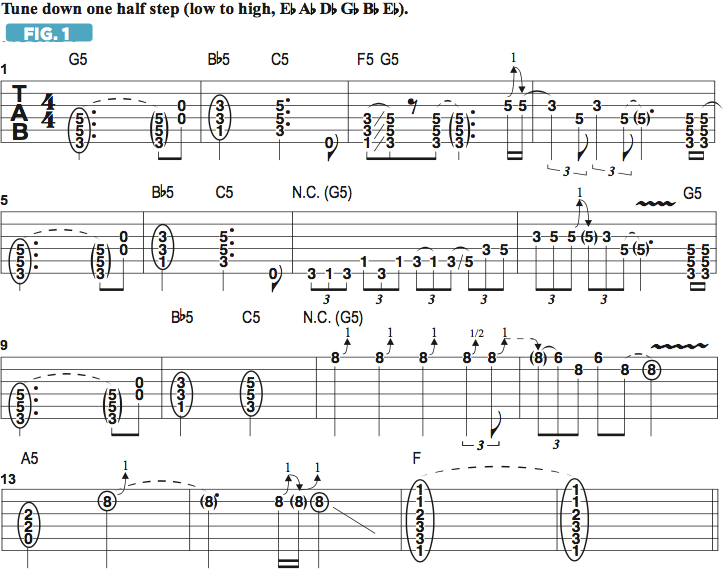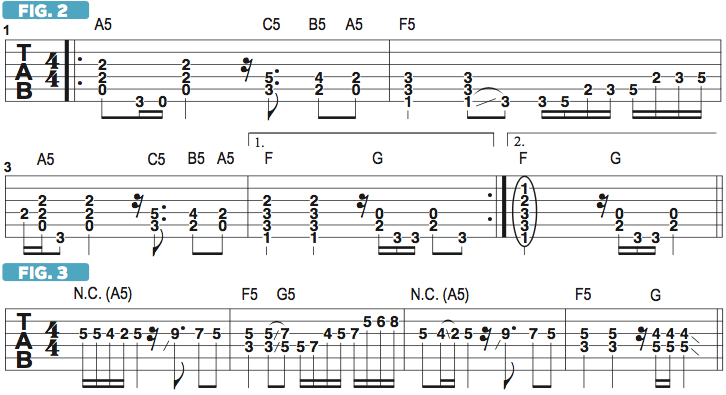Combining Rhythm and Lead Effectively
Nita Strauss dishes on how to seamlessly integrate rhythm and lead techniques into a single unified, powerful guitar part.
One thing I consider essential to becoming a professional guitarist is to learn how to seamlessly integrate rhythm and lead techniques into a single unified, powerful guitar part. Many players can fall into the habit of thinking “Now I’m playing rhythm” and “Now I’m playing lead,” and for each role, they feel they have to hold the pick differently, change the angle of their fretting hand, or what have you. In truth, when interjecting melodic licks and fills into a rhythm part, you really don’t need to change your mindset or technical approach much at all.
FIGURE 1 offers an example that combines rhythm playing and soloing. In this example, I alternate between two bars of rhythm and two bars of lead: each four-bar phrase begins with a G5 power chord, held for four beats, followed by half-note Bf5 and C5 chords. In bar 3, I restate the G5 chord before dropping in a simple, bluesy lick based on the G minor pentatonic scale (G Bb C D F) that carries into bar 4. After the chords in bars 5 and 6, bar 7 features a G minor pentatonic lick that ascends in steady eighth-note triplets and reaches its conclusion in bar 8. Bars 9 and 10 restate the chords, and bars 11 and 12 set up a switch to A5, a sustained G-to-A bend, and the final F barre chord that concludes the example.
One of the coolest things about playing in the Alice Cooper band is that we have three guitar players—myself, Tommy Henriksen and Ryan Roxie—which provides the opportunity to create what producer Bob Ezrin likes to call the “big wall of sound.” With three guitarists, one can hold down a rhythm part while the other two are free to play two-part harmonies, and we can recreate everything we need live, 100%.

FIGURES 2 and 3 illustrate how we’ll typically take a specific guitar part and add some twists to it. FIGURE 2 represents the primary part and kicks off with syncopated accents on A5, followed by the descending chord progression C5 B5 A5 F5; bar 2 culminates the line with an ascending lick based on the A Aeolian mode, also known as the A natural minor scale (A B C D E F G). Bar 3 is a restatement of bar 2, and bar 4 serves as the first ending to the four-bar phrase, moving from F to G.
FIGURE 3 shows the supplemental guitar part, which begins by harmonizing the descending line in bar 1 of FIGURE 2, A G E, an octave and a third above, with the notes C B A. Likewise, the C5 B5 A5 progression is harmonized with single notes—E D C. Bar 2 of FIGURE 3 is basically the same as bar 2 of FIGURE 2, but all notes are transposed up an octave. In bars 3 and 4, the supplemental guitar part continues to mirror the primary part an octave higher.

Tightly intertwining guitar parts like these can lend a song a much more expansive and powerful feeling and vibe, so try using this approach with your band or recording projects.
All the latest guitar news, interviews, lessons, reviews, deals and more, direct to your inbox!
